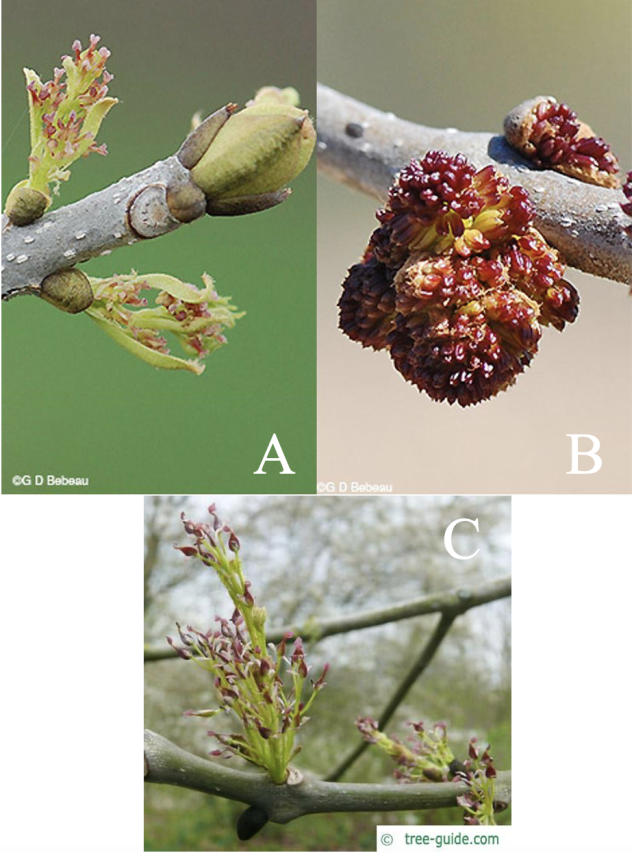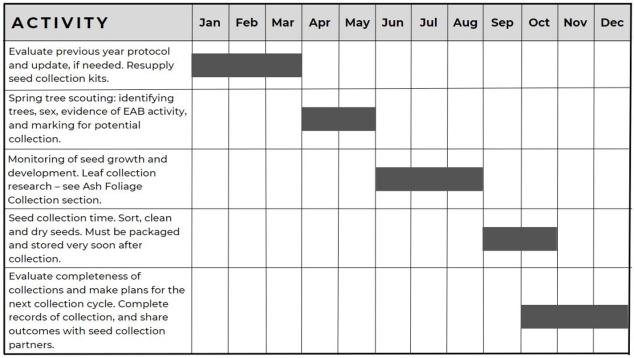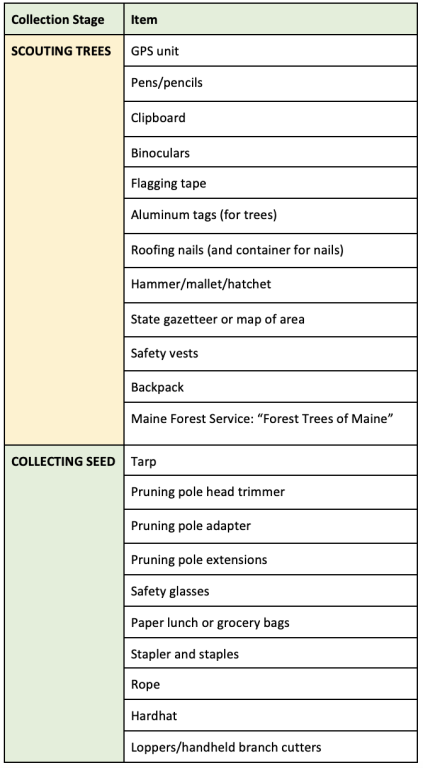Steps for Seed Collection
The following 5 steps walk you through how to collect ash seed in a forest environment. Wild ash should be prioritized over nursery-stock ash due to its genetic diversity. Given that ash trees do not produce seed every year, it is important to gather from as many trees as possible to collect the broadest range of genetic variation.
1. Identify different kinds of ash trees using guidance on the Ash Inventory page.

2. Identify the sex of an ash tree
Brown ash trees have three possible sexes: female, male or polygamous, meaning that the tree can produce both female and male flowers. Identifying the sex of a tree is important as it will indicate which trees can produce seeds. The female trees are often described as wispy or “feathery, yellow panicles, 1 to 2 inches long,” as seen in the picture to the left. Male flowers are rounded or globular, and dark in color. These can often be seen after spring time and into the summer, but they can be hard to distinguish on particularly tall trees and after the tree’s leaves have buds out. Remnants of the flowers are sometimes seen throughout the rest of the year from the ground with binoculars. The female flowers leave behind the stems, making them look like long bristles at the end of the tree branches, and male flowers are dark blobs in the same place, but on male trees. Polygamous trees can be difficult to distinguish unless both parts of flowers are left behind. The female and male flowers bloom at different times to prevent self-pollination, and therefore it is possible to mark a tree as one sex and later see it present as another.

3. Time your seed collection
Ash has a broad range in North America, and different subspecies differ in when they have harvestable seeds. According to partners and seed collection experts with the Akwesasne St. Regis Mohawk Tribe, as well as from basket harvesters and foresters in Maine, it is suggested to begin scouting trees in early spring for flowers and seeds. We suggest using the guidance on the Identifying and Recording Ash page to do so. Seed collecting takes place between August and the first week in October with the processing and storage immediately after collection. The end of October and to December is time to evaluate the collection cycle, complete records, and share outcomes with partners. Late winter, January to March, can be a time for resupplying and updating protocol for the next round of spring tree scouting, and the whole cycle starts again.
List of materials

4. Collect materials for seed collection
Having the proper items for ash seed scouting and collecting is very important. Brown ash, in particular, can be difficult to access due to the wet areas it prefers, and may not be near the vehicle you traveled to reach the forest. This list of items was curated by discussing seed collecting with experts with the Akwesasne St. Regis Mohawk Tribe’s Natural Resources Department, forestry professionals, as well as harvesters, to find what works best for collecting ash seed with the pruning pole method in mind.
Our lab plans to give each Tribal Nation in Maine a seed collection kit. We will have a limited amount of leftover materials for use by seed collectors. If you would like to request seed collection materials, please reach out to Emily Francis at emily.francis@maine.edu.
5. Decide where you're going to send seed
Documentation of trees and seeds collected from these trees are an essential part of the seed collection process. Without it, there would be no data to locate trees after collection. There are two different data collection sheets depending on where you plan to send the seed you collect. You can review your options for seed storage and access the corresponding printable data sheets on the page Storing Ash Seed.
6. Collect seed
Ash trees can vary in height, branch distance from the ground, and surrounding environment, and the methods used to collect seed will vary according to these features. When scouting for ash it is important to take into account how you plan to reach seed to harvest and plan accordingly. Some ash trees may not be reachable with a pruning pole, or may require more pruning poles than suggested in our seed kit item list. Please visit our Ash Seed Collection Manual for detailed descriptions of different methods of collecting seed, including pole pruning, tarp shaking with a rope and weight, rope saw, or by hand. Or, for a more technical review of methods, check out the USDA Forest Service’s pamphlet, Methods for Collecting Ash Seed.
After you collect, remember to document your seed collection using the sheets posted on the Processing and Storing Ash Seed page, and then navigate to the page Seed Collection Map and Reporting Form to let us know you collected seed.
Other Resources
Recommendations For The Collection, Storage, And Germination Of Ash (Fraxinus Spp.) Seed, By Dave Ellis, USDA, 2007.
